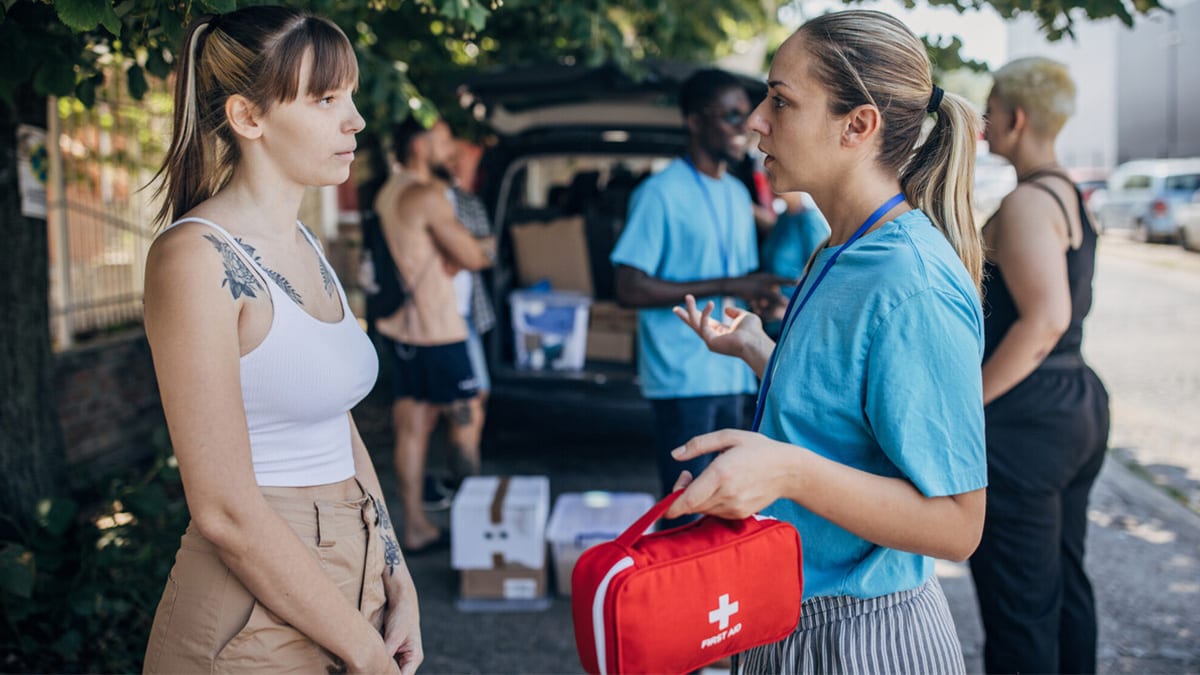Key points
- Syringe services programs are community prevention programs that provide a range of services that prevent spread of disease and protect communities.
- They are proven to save lives, help those with substance use disorders get needed support, prevent overdose deaths, and reduce the impact of drug use on the community.

What it is

Syringe services programs (SSPs) are community-based prevention programs that provide a range of services. These services include:
- Links to substance use disorder treatment
- Access to and disposal of sterile syringes and injection equipment
- Vaccination
- Testing
- Links to care and treatment for infectious diseases
SSPs protect the public and first responders by providing safe disposal of used needles and syringes. SSPs also prevent outbreaks of other diseases by providing:
- Testing
- Counseling
- Sterile injection supplies
Nearly thirty years of research show that comprehensive SSPs are:
- Safe and effective
- Cost-saving
- Not increasing illegal drug use or crime
- Reducing spread of viral hepatitis, HIV, and other infections
Why it matters

The majority of new hepatitis C virus (HCV) infections are due to injection drug use. Reports of HCV cases rose 3.5-fold from 2010 to 2016.1 Additionally, more than 2,500 new human immunodeficiency virus (HIV) infections each year are due to people who inject drugs.2
The best way to prevent the spread of these diseases for people who inject drugs is to stop injecting them. If that is not possible, use sterile injection equipment for each injection to reduce the risk of infection and prevent outbreaks.
SSPs are associated with an estimated 50% reduction in HIV and HCV infections. Transmission is reduced by over two-thirds34 when combined with medications that treat opioid dependence (also known as medication-assisted treatment).
SSPs act as a bridge to other health services, including HCV and HIV testing and treatment and medication-assisted treatment.5
Outcomes
Most SSPs offer referrals to medication-assisted treatment.6 New SSP users are five times more likely to enter drug treatment. They are also three times more likely to stop using drugs than those who don't use the program.
SSPs prevent overdose deaths by teaching people who inject drugs:
- How to recognize and prevent overdose
- How to recognize, respond to, and reverse overdose
- How to use naloxone, a medication that reverses overdose
Many SSPs provide "overdose prevention kits" that contain naloxone to people who inject drugs.789101112
Strategies
SSPs partner with local law enforcement and provide them with naloxone. This helps local police departments respond to and prevent death when someone has overdosed.13
SSPs also protect first responders and the public by providing safe needle disposal. This reduces the amount of discarded needles in the community.141516171819
A 2015 study by the CDC's National HIV Behavioral Surveillance System found how SSPs' clean needle programs help communities. The more syringes distributed per the number of people who inject drugs, the more likely used syringes would be disposed of safely.20
However, studies in Baltimore 21and New York City22 found that crime rates did not change if an area had SSPs or not.
- Centers for Disease Control and Prevention. Surveillance for Viral Hepatitis — United States, 2016.
- Centers for Disease Control and Prevention. Estimated HIV incidence and prevalence in the United States, 2010–2015. HIV Surveillance Supplemental Report. 2018;23(No. 1). Published March 2018.
- Platt L, Minozzi S, Reed J, et al. Needle syringe programmes and opioid substitution therapy for preventing hepatitis C transmission in people who inject drugs. Cochrane Database Syst Rev. 2017;9:CD012021. doi:10.1002/14651858.CD012021.pub2.
- Fernandes RM, Cary M, Duarte G, et al. Effectiveness of needle and syringe programmes in people who inject drugs – An overview of systematic reviews. BMC Public Health. 2017;17(1):309. doi:10.1186/s12889-017-4210-2.
- HIV and Injection Drug Use – Vital Signs – CDC. Centers for Disease Control and Prevention. Published December 2016.
- Des Jarlais DC, Nugent A, Solberg A, Feelemyer J, Mermin J, Holtzman D. Syringe service programs for persons who inject drugs in urban, suburban, and rural areas — United States, 2013. MMWR Morb Mortal Wkly Rep. 2015;64(48):1337-1341. doi:10.15585/ mmwr.mm6448a3.
- Seal KH, Thawley R, Gee L. Naloxone distribution and cardiopulmonary resuscitation training for injection drug users to prevent heroin overdose death: A pilot intervention study. J Urban Health. 2005;82(2):303–311. doi:10.1093/jurban/jti053.
- Galea S, Worthington N, Piper TM, Nandi VV, Curtis M, Rosenthal DM. Provision of naloxone to injection drug users as an overdose prevention strategy: Early evidence from a pilot study in New York City. Addict Behav. 2006;31(5):907-912. doi:10.1016/j. addbeh.2005.07.020.
- Tobin KE, Sherman SG, Beilenson P, Welsh C, Latkin CA. Evaluation of the Staying Alive programme: Training injection drug users to properly administer naloxone and save lives. Int J Drug Policy. 2009;20(2):131-136. doi:10.1016/j.drugpo.2008.03.002.
- Doe-Simkins M, Walley AY, Epstein A, Moyer P. Saved by the nose: Bystander-administered intranasal naloxone hydrochloride for opioid overdose. Am J Public Health. 2009;99(5):788-791. doi:10.2105/ajph.2008.146647.
- Bennett AS, Bell A, Tomedi L, Hulsey EG, Kral AH. Characteristics of an overdose prevention, response, and naloxone distribution program in Pittsburgh and Allegheny County, Pennsylvania. J Urban Health. 2011;88(6):1020-1030. doi:10.1007/s11524-011-9600-7.
- Leece PN, Hopkins S, Marshall C, Orkin A, Gassanov MA, Shahin RM. Development and implementation of an opioid overdose prevention and response program in Toronto, Ontario. Can J Public Health. 2013;104(3):e200-204.
- Childs R. Law enforcement and naloxone utilization in the United States. FDA website.
- Tookes HE, Kral AH, Wenger LD, et al. A comparison of syringe disposal practices among injection drug users in a city with versus a city without needle and syringe programs. Drug Alcohol Depend. 2012;123(1-3):255-259. doi:10.1016/j.drugalcdep.2011.12.001.
- Tookes HE, Kral AH, Wenger LD, et al. A comparison of syringe disposal practices among injection drug users in a city with versus a city without needle and syringe programs. Drug Alcohol Depend. 2012;123(1-3):255-259. doi:10.1016/j.drugalcdep.2011.12.001.
- Klein SJ, Candelas AR, Cooper JG, et al. Increasing safe syringe collection sites in New York State. Public Health Rep. 2008;123(4):433-440. doi:10.1177/003335490812300404.
- de Montigny L, Vernez Moudon A, Leigh B, Kim SY. Assessing a drop box programme: a spatial analysis of discarded needles. Int J Drug Policy. 2010; 21(3):208-214. doi:10.1016/j.drugpo.2009.07.003.
- de Montigny L, Vernez Moudon A, Leigh B, Kim SY. Assessing a drop box programme: a spatial analysis of discarded needles. Int J Drug Policy. 2010; 21(3):208-214. doi:10.1016/j.drugpo.2009.07.003.
- Bluthenthal RN, Anderson R, Flynn NM, Kral AH. Higher syringe coverage is associated with lower odds of HIV risk and does not increase unsafe syringe disposal among syringe exchange program clients. Drug Alcohol Depend. 2007;89(2-3):214-222.
- Centers for Disease Control and Prevention. HIV Infection, Risk, Prevention, and Testing Behaviors among Persons Who Inject Drugs—National HIV Behavioral Surveillance: Injection Drug Use, 20 U.S. Cities, 2015. HIV Surveillance Special Report 18. Revised edition. Published May 2018. Accessed July 30, 2018.
- Marx MA, Crape B, Brookmeyer RS, et al. Trends in crime and the introduction of a needle exchange program. Am J Public Health. 2000;90(12),1933–1936.
- Galea S, Ahern J, Fuller C, Freudenberg N, Vlahov D. Needle exchange programs and experience of violence in an inner city neighborhood. J Acquir Immune Defic Syndr. 2001;28(3),282-288.
